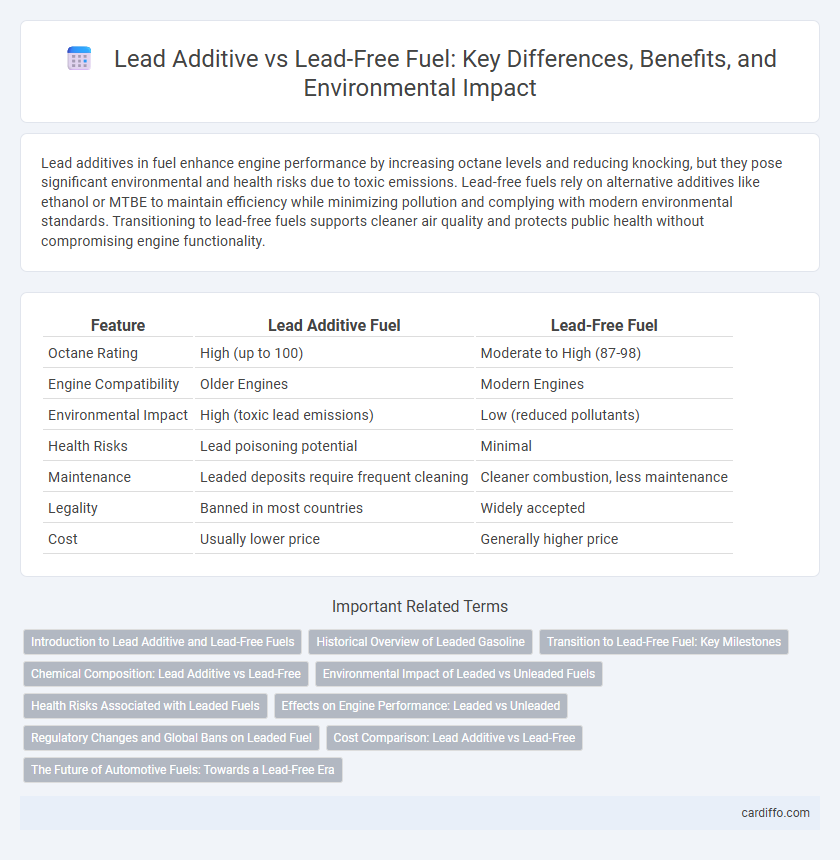Lead additives in fuel enhance engine performance by increasing octane levels and reducing knocking, but they pose significant environmental and health risks due to toxic emissions. Lead-free fuels rely on alternative additives like ethanol or MTBE to maintain efficiency while minimizing pollution and complying with modern environmental standards. Transitioning to lead-free fuels supports cleaner air quality and protects public health without compromising engine functionality.
Table of Comparison
| Feature | Lead Additive Fuel | Lead-Free Fuel |
|---|---|---|
| Octane Rating | High (up to 100) | Moderate to High (87-98) |
| Engine Compatibility | Older Engines | Modern Engines |
| Environmental Impact | High (toxic lead emissions) | Low (reduced pollutants) |
| Health Risks | Lead poisoning potential | Minimal |
| Maintenance | Leaded deposits require frequent cleaning | Cleaner combustion, less maintenance |
| Legality | Banned in most countries | Widely accepted |
| Cost | Usually lower price | Generally higher price |
Introduction to Lead Additive and Lead-Free Fuels
Lead additives, primarily tetraethyl lead, were historically used in gasoline to enhance engine performance by increasing octane ratings and preventing knocking. Lead-free fuels, developed to reduce environmental and health hazards, utilize alternative additives such as ethanol or MTBE to maintain octane levels without releasing toxic lead emissions. The shift from leaded to unleaded fuels has significantly contributed to improved air quality and reduced lead contamination worldwide.
Historical Overview of Leaded Gasoline
Leaded gasoline, first introduced in the 1920s with tetraethyl lead as an anti-knock agent, significantly improved engine performance and reduced knocking in combustion engines. This additive was widely adopted worldwide despite growing evidence linking lead emissions to severe environmental and public health issues, such as neurological damage and air pollution. The gradual phase-out of leaded gasoline began in the 1970s, culminating in a near-global ban by the early 21st century, replaced by unleaded fuels that use alternative anti-knock additives like ethanol and MTBE.
Transition to Lead-Free Fuel: Key Milestones
The transition to lead-free fuel began in the 1970s when environmental regulations, such as the U.S. Clean Air Act, mandated the phase-out of tetraethyl lead to reduce air pollution and health risks. By the 1990s, most gasoline sold in developed countries was lead-free, supported by advancements in catalytic converter technology that required unleaded fuel to function properly. The global shift culminated with the widespread adoption of unleaded petrol, significantly decreasing lead emissions and improving public health outcomes worldwide.
Chemical Composition: Lead Additive vs Lead-Free
Lead additives in fuel primarily consist of tetraethyl lead (TEL), a compound designed to increase octane rating and prevent engine knocking by acting as an anti-knock agent. Lead-free fuels replace TEL with alternative oxygenates like ethanol or MTBE, which enhance combustion efficiency without the toxic environmental and health impacts associated with lead. The chemical composition shift from lead-based additives to organic compounds significantly reduces lead emissions, contributing to cleaner air quality and compliance with stringent environmental regulations.
Environmental Impact of Leaded vs Unleaded Fuels
Leaded fuels release toxic lead compounds into the environment, causing soil and water contamination and posing severe health risks to humans and wildlife. Unleaded fuels significantly reduce air pollution by eliminating lead emissions, contributing to improved air quality and lower rates of respiratory diseases. Transitioning to unleaded fuel supports ecosystem preservation and aligns with global efforts to minimize hazardous pollutants in the atmosphere.
Health Risks Associated with Leaded Fuels
Lead additives in fuel release toxic lead particles into the environment, which accumulate in the human body and cause severe health issues such as neurological damage, cognitive impairments, and cardiovascular problems. Exposure to leaded fuels disproportionately affects children, leading to developmental delays and behavioral disorders due to their higher susceptibility. Transitioning to lead-free fuels significantly reduces these health risks by eliminating airborne lead contamination and promoting cleaner air quality.
Effects on Engine Performance: Leaded vs Unleaded
Leaded fuel enhances engine durability by providing a protective cushion on valve seats, reducing wear and preventing valve seat recession in older engines. Unleaded fuel, while environmentally superior, may cause increased valve seat wear in engines not designed for it, potentially leading to decreased engine performance over time. Modern engines designed for unleaded fuel incorporate hardened valve seats and advanced materials, ensuring optimal performance without the need for lead additives.
Regulatory Changes and Global Bans on Leaded Fuel
Global regulatory changes have mandated the phase-out of lead additives in fuel due to their severe environmental and health impacts. Over 170 countries have enacted bans on leaded gasoline following World Health Organization guidelines and UNEP initiatives aimed at eliminating lead exposure. The transition to lead-free fuel aligns with international air quality standards, significantly reducing lead pollution and safeguarding public health worldwide.
Cost Comparison: Lead Additive vs Lead-Free
Lead additives reduce engine knock and improve fuel efficiency but often increase overall fuel costs due to production complexities and environmental regulations. Lead-free fuels, while sometimes more expensive per gallon, offer long-term savings by reducing engine wear and environmental compliance costs. The upfront price difference is offset by lower maintenance expenses and regulatory benefits associated with lead-free fuel.
The Future of Automotive Fuels: Towards a Lead-Free Era
The transition to lead-free automotive fuels is accelerating globally due to stringent environmental regulations and advancements in catalytic converter technology that require unleaded gasoline for optimal performance. Lead additives, once used to boost octane levels and prevent engine knocking, are now largely phased out because of their toxic effects on human health and ecosystems. Emerging biofuels and synthetic fuels offer cleaner, sustainable alternatives that align with the push towards zero-emission vehicles and reduced air pollution.
Lead Additive vs Lead-Free Infographic

 cardiffo.com
cardiffo.com